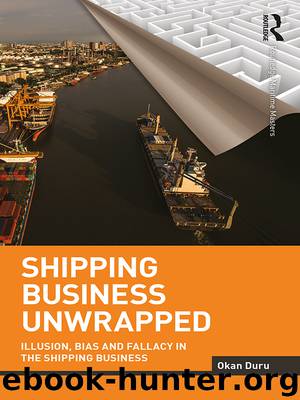Shipping Business Unwrapped by Okan Duru

Author:Okan Duru
Language: eng
Format: epub, pdf
Publisher: Taylor & Francis (CAM)
Figure 10.2 Ship mortgage system and ship covered (mortgage-backed) bonds
A critical connection to shipping loans and common equity arises from the ‘negative equity’ debate. When the value of an asset (ship) is less than the remaining loan, then the difference causes negative equity. Therefore, the ship valuation method also contributes to measuring the equity as an indicator for Basel standards.
The VaR approach presents us with some tough questions about monitoring shipping loans. In his mind-blowing book The Number That Killed Us: A Story of Modern Banking, Flawed Mathematics, and a Big Financial Crisis, Pablo Triana (2011) criticized the principles behind the VaR method and even blames it for being a leading driver of the financial crisis. Although it seems quite objective and fair, several subjective gaps underlie its complicated functions. Selection of distributions or data sets is subject to the arbitrary preferences of experts. The subjective inputs of risk monitoring are among topics currently debated in the banking industry. In particular, regulators find it difficult to slow down funding of toxic loans when there is a boom market. The downturn that follows makes this easier, though it is usually too late for a proper countermeasure.
In the sudden downturn of 2008, ship prices declined significantly and the minimum value mechanism raised a serious problem. Shipping banks have had huge shipping portfolios, and most of these assets were under default risk in terms of contracts while shipowners were somewhat able to pay back. The ‘ship mortgage crisis’ has been postponed somewhat due to the uncertain and tricky nature of ship valuations. There are several reasons for ship valuations (insurance, company valuation, court sales, etc.) and several methods of valuation. Mark-to-market valuation is simply the potential price of the ship in the current market with the assumption of potential buyers and sellers. In the case of a peak market, there would be many representative sales with similar technical details; thus, one may find a very accurate value of the ship. In the case of a slowdown, it is not easy to find representative sales, and experts tend to estimate prices based on a pseudo-sale scenario. The mark-to-market method is frequently used for minimum value constraint, although it has introduced a massive default problem. As an alternative, shipping banks have begun to use mark-to-model (valuation based on a model estimation) and discounted cash flow (DCF) methods (also income methods).
As a DCF-based valuation method, the Hamburg Ship Valuation Standard (HSVS)—in other words, long-term asset value (LTAV)—was developed and enacted in German law on May 6, 2008. The HSVS method has been used by German banks to eliminate massive foreclosures based on monitoring asset values. In the subprime mortgage crisis, defaults by subprime (risky) borrowers meant that many houses were transferred to bank ownership as these assets were not sufficient repay the outstanding debts due to declining house prices. Therefore, mortgage-backed bonds have lost their credibility, and credit default swap buyers (a kind of insurance for credit default) have begun to write down the insured values.
Download
This site does not store any files on its server. We only index and link to content provided by other sites. Please contact the content providers to delete copyright contents if any and email us, we'll remove relevant links or contents immediately.
| Automotive | Engineering |
| Transportation |
Small Unmanned Fixed-wing Aircraft Design by Andrew J. Keane Andras Sobester James P. Scanlan & András Sóbester & James P. Scanlan(32763)
Navigation and Map Reading by K Andrew(5132)
Endurance: Shackleton's Incredible Voyage by Alfred Lansing(4715)
And the Band Played On by Randy Shilts(2163)
The Box by Marc Levinson(1964)
Top 10 Prague (EYEWITNESS TOP 10 TRAVEL GUIDES) by DK(1955)
Wild Ride by Adam Lashinsky(1950)
The Race for Hitler's X-Planes: Britain's 1945 Mission to Capture Secret Luftwaffe Technology by John Christopher(1836)
The One Percenter Encyclopedia by Bill Hayes(1810)
Trans-Siberian Railway by Lonely Planet(1725)
Girls Auto Clinic Glove Box Guide by Patrice Banks(1706)
Bligh by Rob Mundle(1675)
Looking for a Ship by John McPhee(1651)
Good with Words by Patrick Barry(1639)
Batavia's Graveyard by Mike Dash(1632)
TWA 800 by Jack Cashill(1625)
Fighting Hitler's Jets: The Extraordinary Story of the American Airmen Who Beat the Luftwaffe and Defeated Nazi Germany by Robert F. Dorr(1610)
Troubleshooting and Repair of Diesel Engines by Paul Dempsey(1576)
Ticket to Ride by Tom Chesshyre(1566)
